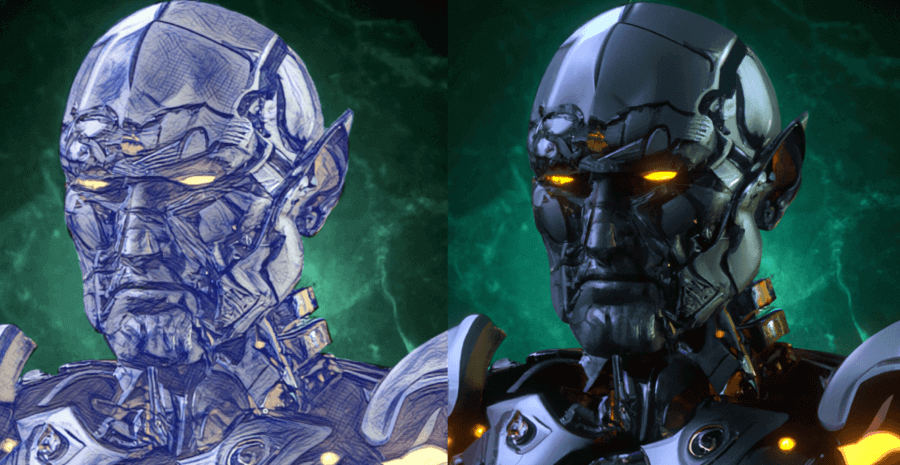From 2D to 3D: A Comprehensive Guide to Creating 3D Characters from 2D Designs

Introduction:
Are you a game developer, animator, or product designer looking to create immersive 3D characters from 2D designs? The ability to create 3D models from 2D images can save time and effort by providing a quick and efficient way to prototype ideas or designs. In this comprehensive guide, we will walk you through the process of creating 3D characters from 2D designs, from modeling to texturing and animating. Additionally, we'll answer common questions and provide tips and tricks to help you achieve the best results.
2D to 3D modeling:
It is a process of converting flat 2D images or sketches into 3D models. This technique is widely used in the fields of game development, animation, product design, and architecture.
The demand for 3D models is increasing, especially in the gaming and animation industries. But what if you have a 2D character design and want to bring it to life in 3D? That's where 2D to 3D character modeling comes in, allowing you to transform your 2D design into a fully realized 3D character.
Technology advancements have made 2D to 3D modeling more accessible to users, resulting in an increased demand for 3D content. This comprehensive guide will walk you through the process of creating 3D characters from 2D designs, from modeling to texturing and animating. We will provide practical tips and tricks to help you achieve the best results.
2D to 3D Character Modeling
The process of converting a 2D character is predominantly used in 2D to 3D character modeling and involves process of converting a 2D character design into a fully realized 3D model. It involves techniques such as UV mapping, texture mapping, and rigging to bring the character to life in a 3D environment. The process can be challenging, but it offers many benefits for creating immersive gaming experiences and animated films.
Difference between 2D and 3D design.
2D design refers to creating images or graphics that exist only in two dimensions: height and width. This includes drawings, paintings, and digital graphics such as icons, logos, and user interface designs. In 2D design, the artist or designer creates the illusion of depth and perspective using techniques such as shading, colors, and gradients.
On the other hand, 3D design involves creating objects that have height, width, and depth. These objects can be viewed from any angle, and they are often used in video games, movies, and virtual reality experiences. 3D design typically involves creating models using specialized software that allows the designer to manipulate the object in a virtual space. The process may also involve adding texture, color, and lighting effects to create a realistic-looking 3D object.
The key difference between 2D and 3D design is the level of depth and dimensionality. Additionally, 3D design allows for more complex and realistic designs to be created, such as detailed characters or intricate architectural models.
2D design are typically created on a computer screen or on paper. These designs are usually created using software such as Adobe Illustrator or Photoshop. They can be used for a wide variety of purposes, including creating logos, designing websites, or illustrating characters for games.
3D design, on the other hand can be used for a variety of purposes, such as creating animated movies, designing video games, or even prototyping products in the manufacturing industry. 3D design requires more advanced software such as Maya, Blender, or ZBrush.
The benefits of creating 3D characters from 2D designs
One of the biggest benefits of creating 3D characters from 2D designs is that it allows for a more immersive gaming experience. When players are able to see the character from all angles, they can appreciate the design more fully and feel more connected to the game world. Additionally, 3D characters can be animated in a way that 2D characters cannot, allowing for more lifelike movements and expressions.
Another benefit is that 3D models can be reused in different contexts, such as in cutscenes or marketing materials. This can save time and money in the long run.
Common challenges - how to make 2d pictures into perfect 3d models
One of the biggest challenges in creating 3D characters from 2D designs is accurately capturing the original design. This can be especially difficult if the original design is very stylized or has exaggerated proportions. Additionally, converting a 2D design into a 3D model requires a different skill set than creating a 2D design from scratch. It requires an understanding of 3D modeling software, as well as knowledge of anatomy and proportions.
Another misconception is that 3D models are always better than 2D designs. While 3D models can offer more realism and immersion, there are situations where 2D designs may be more appropriate. For example, 2D designs may be more suitable for mobile games or games with simpler graphics. Ultimately, the decision to use 2D or 3D designs depends on the specific needs of the project.
2D vs. 3D Character Design: Pros and Cons:
One significant advantage of 2D character design is its ease of use and flexibility. Artists can quickly draw 2D characters by hand, and it requires less computing power to create 2D animations compared to 3D animations. However, 2D designs lack depth and realism, making it challenging to create immersive gaming experiences. In contrast, 3D character design provides a more realistic and immersive experience for the player. It also enables the designer to create detailed models and animations. However, it requires more advanced skills and experience, and the process can be time-consuming and expensive.
2D character designs can be produced rapidly and inexpensively, making them ideal for small indie game developers or start-ups with limited resources. On the other hand, 3D character design allows for more control over the character's movements and expressions, enabling game developers to create more lifelike and interactive gaming experiences. Ultimately, the choice of approach depends on the goals of the project and the resources available.
Software Applications for 2D to 3D Modeling:
Adobe Photoshop is a popular choice for creating 2D designs, while Blender, Maya, ZBrush, and 3D Coat are commonly used for 3D modeling. When converting a 2D design into a 3D model, the workflow involves several steps, such as creating a base mesh, sculpting the details, texturing the model, and rigging the model for animation. Each software application has its unique features and advantages, and the choice of software depends on the requirements of the project and the skill level of the designer.
Steps IN 2D TO 3D Modeling :
Creating a 3D model from a 2D character sketch is an exciting process that requires a few specific steps. The following are the steps that you can follow to turn your 2D character into a 3D model:
-
Import the 2D Character Sketch into a 3D Modeling Software: The first step is to import the 2D character sketch into a 3D modeling software such as Blender, Maya, or ZBrush. The sketch will be used as a reference image to create the 3D model.
-
Create a Basic 3D Model: Once you have imported the sketch, create a basic 3D model by using the reference image. You can use the extrusion, scaling, and rotation tools to create a simple 3D model of the character. This step is important because it provides a basic structure for the 3D model and makes it easier to add more detail later.
-
Add Details to the Model: Once you have created the basic 3D model, it's time to add details. This is where you can use your creativity to add textures, color, and shading to the model. You can use different tools and techniques to add detail, such as sculpting, painting, and texturing.
-
Create the Rig: The next step is to create a rig for your 3D model. A rig is like a skeleton that helps you animate the model. You can use different rigging tools to create a rig, such as the bone tool, inverse kinematics, or blend shapes.
-
Animate the Model: Finally, it's time to animate your 3D model. You can use different animation tools and techniques to bring your character to life. For example, you can use keyframe animation, motion capture, or procedural animation to animate your 3D model.
Workflows that are used for converting 2D images into 3D models:
Converting 2D images into 3D models involves a specific workflow that typically includes several steps. The first step is to acquire the 2D image and prepare it for processing by adjusting the lighting and shadows. The next step is to extract the necessary features from the image, such as edges, curves, and contours. Once the features are extracted, they are used to create a rough 3D model. The model is then refined by adding more details and textures, which are based on the original image. Finally, the completed 3D model is usually exported in a standard format that can be used by various applications or platforms. There are several software tools available that can automate this process, making it easier for users to convert 2D images into 3D models quickly and efficiently.
Using Blender, Unity, and other software tools to create 3D models:
Unity is a game engine that is widely used by game developers to create both 2D and 3D games. It is a versatile game engine that allows designers to create complex 3D game worlds with various elements, including lighting, textures, and physics. With Unity, 2D characters can easily be brought into 3D environments, adding depth and personality to the game. Unity's tools and features also make it easy to optimize game performance and create engaging gameplay experiences. Blender is also popular software tools used for creating 3D models. Blender is an open-source 3D modeling software that can be used to create detailed 3D models. Other popular game engines include Unreal Engine, CryEngine, and Godot.
Techniques for converting 2D designs to 3D models:
Converting 2D designs to 3D models can be a challenging task, as it requires the artist to capture the essence of the original design and translate it into a 3D space. Some techniques that can be used include extrusion, where 2D shapes are transformed into 3D shapes by pulling them out in the third dimension, and subdivision, where a 2D mesh is divided into smaller parts to create a 3D shape. Another technique is sculpting, where a 3D shape is created by adding or subtracting material from a digital clay-like material.
Practical Tips and Tricks for 2D to 3D Character Modeling:
When creating 3D models from 2D designs, it is important to pay attention to proportions and details to ensure that the final product is accurate and faithful to the original design. One tip is to use reference images or sketches to guide the modeling process. Another tip is to pay attention to the topology of the model, ensuring that the geometry is clean and efficient. It is also important to use good lighting and shading techniques to add depth and realism to the final model. Finally, taking breaks and stepping away from the project periodically can help avoid fatigue and maintain a fresh perspective on the modeling process.
This section will provide more valuable insights and practical tips for creating 3D characters from 2D images. We will cover important topics such as lighting, texture mapping, and character rigging.
Texturing and Shading 3D Models
Creating textures and materials is an essential aspect of 3D modeling, and hence 2D to 3D as well. It adds visual interest and realism to objects. The process involves designing and applying textures and materials that give 3D models a unique look and feel. To apply textures, UV mapping techniques are used to unwrap the 3D model and create a 2D template. These templates are then used to apply textures and materials to the model's surface. Different UV mapping techniques are available, including planar, cylindrical, and spherical mapping, each with its advantages and disadvantages. To achieve the desired look and feel, it's essential to experiment with different textures, materials, and lighting conditions. It's also crucial to pay attention to details such as bump mapping, reflections, and transparency to create more realistic 3D models. With practice and attention to detail, designers can create visually stunning 3D models with unique textures and materials.
Animating 3D Models
Once a 3D model is created, animating it brings it to life. The animation process for 3D characters involves rigging, which involves creating a system of joints and bones to move the model. This allows the animator to create movement by manipulating the joints and bones. There are several common animation techniques used for 2D characters in 3D worlds, including keyframe animation, motion capture, and procedural animation.
Keyframe animation involves setting key points in the animation process, while motion capture uses sensors to track real-life movements and apply them to the model. Procedural animation involves using algorithms to generate movement automatically.
To make 3D animations look 2D, designers can use techniques like cel shading, which applies flat, cartoon-like colors to the model. Another technique is to animate using 2D sprite sheets that are mapped onto the 3D model, giving it a unique and engaging appearance. With the right techniques, designers can bring their 3D characters to life, creating animations that are both realistic and visually stunning.
Best Practices for 2D to 3D Modeling:
To achieve high-quality results when creating 3D models from 2D images or sketches, it is important to follow some best practices. First, it is important to use high-quality 2D images or sketches with as much detail as possible. This can help to ensure that important details are not lost during the conversion process.
Second, it is important to use software tools that are specifically designed for 2D to 3D modeling, such as Adobe Photoshop or Blender. These tools have features and workflows that are optimized for this process, which can help to achieve better results.
Finally, it is important to take the time to refine and optimize the 3D model after the conversion process is complete. This can help to ensure that the final model is accurate and visually appealing.
Conclusion
In conclusion, creating 3D characters from 2D designs can be a challenging process, but it is also a rewarding one. With the right software tools, techniques, and workflows, it is possible to create immersive 3D characters that bring 2D designs to life in a whole new way. Whether you are a game developer, animator, product designer, or architect, 2D to 3D modeling can save time and effort, while also allowing you to explore new creative possibilities. We hope that this comprehensive guide has provided you with valuable insights, tips, and tricks to help you achieve the best results when creating 3D characters from 2D designs.
2D to 3D character modeling requires a variety of skills and tools. By using software applications such as Adobe Photoshop, Blender, Maya, ZBrush, and Unity, along with various techniques like texture mapping and character rigging, designers can create immersive and engaging 3D characters from 2D designs.
These 3D characters can enhance the gaming experience, provide new opportunities for animation and storytelling, and open up new revenue streams for content creators. With the help of My3DModels, designers can bring their 2D characters to life and create stunning 3D models that capture the essence of their original designs. By following the tips and tricks outlined in this guide, designers can create high-quality 3D characters that will captivate audiences and stand the test of time.
Frequently Asked Questions
Question 1) What is the cost of creating a 2D/3D cartoon character?
The cost of creating a 2D/3D cartoon character can vary widely depending on the complexity of the design, the level of detail required, and the software used. It is best to contact us with details to get a more accurate estimate.
Question 2) Can 3D characters be used in 2D Unity games?
Yes, 3D characters can be used in 2D Unity games. They can be rendered as 2D sprites or use techniques like billboard rendering to create the illusion of 2D movement.
Question 3) How to code 2D characters in 3D space in Unreal Engine?
To code 2D characters in 3D space in Unreal Engine, you can use the Paper2D plugin. This plugin allows you to import 2D sprite sheets and create 2D animations that can be placed and manipulated in 3D space. You can also use the Flipbook node to create 2D animations and apply them to 3D objects.




